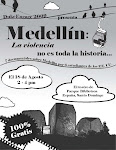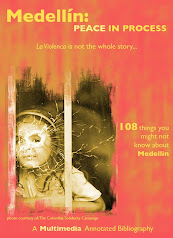"Doña Clara asked me about a week in what my first impression was of Medellín. My answer: color. Coming from the gray, classic structures of Washington D.C. and the content brick of the Northern Virginia suburbia, I was shocked at the explosion of color throughout the city. From the clothing to the restaurants to the flowers to the poorest houses – everything has splashes of yellows and reds and blues and greens. As I’ve lived longer in the city, I think that color is not just a physical entity but a fact of spirit as well. The nights in Carlos E. Restrepo are alive with the colors of university students mingling with friends, professors, ladies selling jewelry, and a lone man playing the flute for money. The Parques Bibliotecas, Parque Explora, and the other relatively new buildings bring the city to life in full Technicolor with their modern architecture and the energy of the people who work and play there. Maybe it’s the weather – the constant pure blue skies of the City of Eternal Spring – that originally brought the color into play throughout the city. But it has become a constant fixture in the lives of its inhabitants. People live in color compared to the black and white of the United States. Friends are openly affectionate – it’s okay to express your feelings. People greet and kiss almost total strangers, welcoming them into their homes, offering the best they can, opening their hearts and pouring out this warmth from the soul that can’t help but color your world a little brighter. It’s something as simple as the idea of fresh fruit juice anywhere you go, from any fruit you can imagine, yet also something as deep as the unbroken spirit of the children in the poorest neighborhoods, who have painted murals on their roofs to speak to the passengers on the MetroCable. I’m so excited to spend the rest of my summer in a city so full of life, energy, and love. My Spanish literature teacher in high school tried so hard to explain the meaning of one vocab word, but living in the color of Medellín I actually feel it: el vaivén de la ciudad."
"In the past week and a half, the thing I’ve found most interesting is how Colombian values differ from American values. The most obvious example, perhaps, is time. Time, schedules, plans and the general overall stress that Americans place on having a defined schedule are really not so rigorously maintained here. It’s kind of a nice change of pace because it feels so much more mellow and relaxed. At the same time, frustrations do tend to run high when things are running hours off schedule or when we have no idea what’s going on or where everyone is.
The next thing is cleanliness and orderliness. Honestly, as Americans, I think we tend to look down upon other people in terms of maintaining hygienic conditions. Certainly, people tend to have a negative view of poorer countries. But I’ve come to realize that Colombians are extremely proud of things being neat and presentable. Everyone I’ve talked to about the Metro, for example, first tells me quite proudly that it’s the cleanest metro I will ever see. All the public spaces here, in fact, are free from garbage and are constantly cleaned and looked after. My host mom washes my clothes almost everyday and expects me to keep my room clean and my bed made. Of course, not all of Medellín is as clean as where we live and not all Colombians are the same way, but to me, it’s kind of refreshing to realize that Medellín could be an example of public orderliness for a city like New York.
Also, the emphasis on food is both extremely fun and amusing, and sometimes a bit tedious. It always makes me laugh a little when my host mom serves me an enormous breakfast and then is somewhat taken aback when she realizes how little I eat relative to the average Colombian. This week of touring COMFAMA’s projects and buildings has been kind of hilarious since we are always served at least a beverage and sometimes a whole meal, even after we’ve just eaten. Don’t even get me started on the típico and all the meat! But at the same time, I really like how food is a pastime here, because sometimes in the U.S., this gets lost in the rush of eating just to be full rather than sitting down and enjoy food with friends and family.
Finally, I really love the strong connections that Colombians seem to have with family. This may be just my own experience from having my host mom and her large extended family (including Danya’s host family), but it’s a lot of fun. People generally tend to stay close to their family in terms of distance and time spent together, and even the nieces, nephews, cousins, etc. remain close to each other. It’s a value that I really love and wish I would see more of in the U.S."




Post a Comment